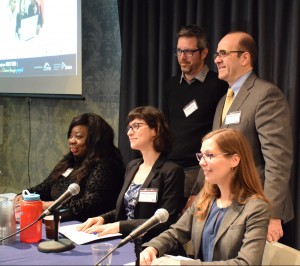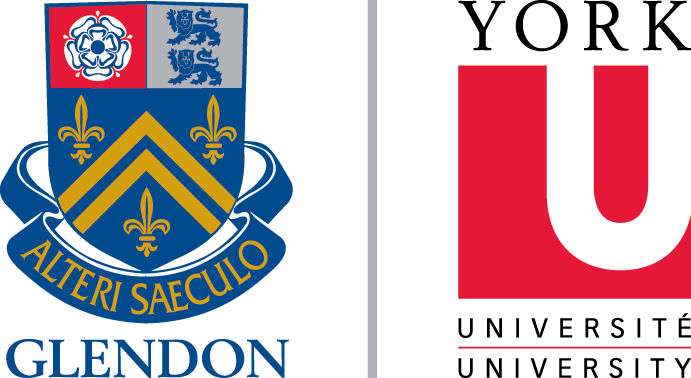
From left to right: (seated) Léonie Tchatat (La Passerelle-I.D.É.), Mireille Paquet (Concordia University), Jennifer Gray (Ministry of Citizenship, Immigration and International Trade); (standing) Francis Garon (Glendon) and Daniel Salée (Concordia University).
As part of the Québec-Ontario Conference (“Where Do We Stand Today?”), a number of former holders of the Québec Studies Chair gave their assessment of 400 years of francophone immigration in the provinces of Ontario and Québec.
What trends can be discerned with regard to francophone migrations? What opportunities lie ahead? This attempt to look forward from the past was one of the themes addressed in the celebrations of Glendon’s 50th anniversary.
Ontario is known as Canada’s most multicultural province. It is the destination for 40% of immigrants, and 29% of residents were not born in the province.
Even so, Ontario seems to be lagging behind in immigration matters. Admittedly, it is the only province that offers immigration programs dedicated to francophones, but a comparison of the situations in Ontario and Québec quickly reveals certain distortions.
In the 1970s and 1980s, Ontario claimed to be a leader in immigration issues and increased its services in an effort to achieve “social justice.” The Harris Government (1995-2003) wasted no time in putting this vision on hold; in so doing, it brought an end to the advances that had been made, and substituted a discourse based on fear.
It is these years of governance that explain the delay we see in Ontario with regard to immigration. In Québec, however, the governance structure as it relates to immigration appears to remain stable over time – a structure that is simultaneously effective and democratic.
The two strengths of the Québec francophone community movement lie in the protection of collective rights through community agencies and in the criticisms levelled by the Table de concertation des organismes au service des personnes réfugiées et immigrantes (TCRI) [issue table for organizations serving immigrants and refugees]. Note should be taken of the concept of “interculturalism,” a notion specific to Québec that also sets out major goals, such as raising diversity awareness, and plays a significant role in the area of francophone migration.
In Ontario, the 2003 elections and the Liberal Party’s taking the reins of power marked the return of a positive vision of immigration. Under the premiership of Dalton McGuinty (2003-2013), the Canada-Ontario Agreement came into effect and provided expanded resources for settlement services and language training.
While the 2005-2010 agreement was not renewed, the federal government did promise immigration services; indeed, Ontario is counting on immigration to further its growth. The Ontario Immigrant Nomination Program (OINP) had a goal of 2,500 designations for 2015.
Although we are indeed faced with an interventionist policy, we still seem to be a long way off from returning to the former “social justice” concept advocated in the 1980s. The OINP permanent residencies give priority to “human capital” (education level, language level). Immigration is therefore seen as a “resource” for the province.
By Laurence Stenvot, published in Le Métropolitain on December 31, 2015


